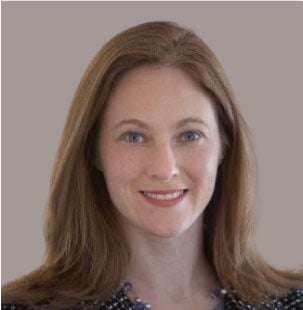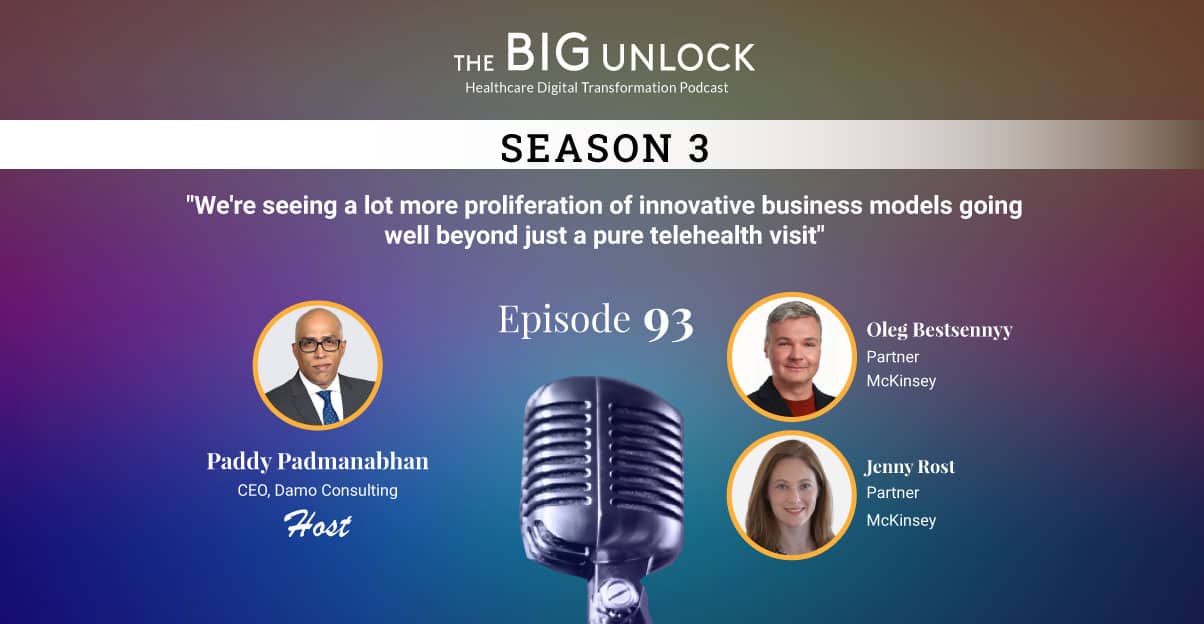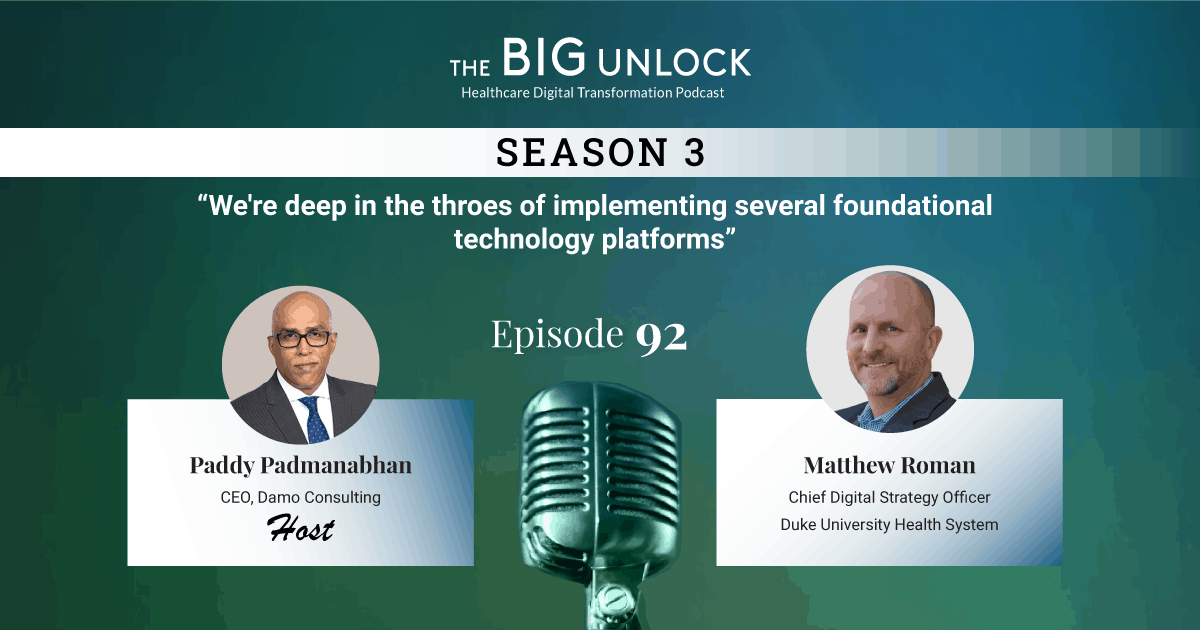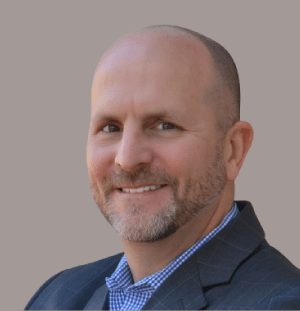Season 3: Episode #93
Podcast with Oleg Bestsennyy and Jenny Rost, McKinsey
"We’re seeing a lot more proliferation of innovative business models going well beyond just a pure telehealth visit"
 Hosted by Paddy Padmanabhan
Hosted by Paddy Padmanabhan 
Share
In this episode, McKinsey partners Oleg Bestsennyy and Jenny Rost discuss the findings of their recently published report – ‘Telehealth: A quarter-trillion-dollar post-Covid-19 Reality?’ The conversation highlights the rapid growth of telehealth since the pandemic and explores several important differences in adoption rates based on types of care, demographic profiles, and other factors.
Telehealth can be a great enabler for delivering innovations that lead to better quality healthcare, member experience, and lower costs. There is a need for continued innovation to sustain and expand telehealth and investment in building seamless consumer experiences, especially in a hybrid care model.
The report provides several interesting charts that inform readers on the emerging landscape of telehealth and virtual care models. Oleg and Jenny also discuss various headwinds that will impact the growth of telehealth technologies in the future. They also share advice for health systems and health plan executives looking to navigate the transition to virtual care models successfully. Take a listen.
Show Notes |
||||
| 00:43 | McKinsey just published a report titled Telehealth: a quarter-trillion-dollar post-covid reality? What are the key findings of the study? | |||
| 04:48 | The report mentions that telehealth volumes have dropped off from the pandemic peaks. Have we reached an equilibrium or are we still evolving towards a steady-state hybrid model? | |||
| 11:42 | You mentioned one headwind in telehealth adoption, which is the reimbursement environment. What else could be a significant headwind and what is your study indicates? | |||
| 13:49 | Healthcare is behind other sectors like ecommerce, personal banking and faces real infrastructure as well as design issues. Where do you think health systems and large health plans are today? | |||
| 17:05 | You refer to the VC funding levels for digital health which is driving a lot of innovation in the report. What are you seeing at the other end in terms of acceptance and adoption for these solutions by health systems? | |||
| 19:40 | Can you comment on the competitive landscape: big tech firms, digital health startups, EHR vendors? What is the tech landscape looking like at health systems in a virtual care future? | |||
| 21:38 | Do you think employers are going to become a significant force that's going to chip away at a big part of the overall healthcare services marketplace? | |||
| 28:18 | What would you advise health systems and health plan executives who are trying to sort through this changing landscape, the shift towards virtual care, and are faced with big investment decisions as it relates to technology | |||
Q: McKinsey just published a report titled “Telehealth: A quarter-trillion-dollar post-COVID reality?” What are the key findings of the study?
Oleg: It’s worth noting that this article ended with a question mark. Is this quarter-trillion-dollar opportunity going to be a reality? The original article, from over a year ago, tried to outline the potential for telehealth. We arrived at a figure very close to USD 250 billion of care that could potentially be shifted given the underlying fundamentals to telehealth. Recently, we looked at it to ask what had happened since the pandemic started and how this had evolved?
The key findings have been – Telehealth accounts for around 13-17% of all office and outpatient visits in the U.S. That is between 30 to 40 times the pre-pandemic levels. This has been fairly stable since June 2020 has been exciting. It’s continued with variability since June though. I must point out here that despite average telehealth adoption, there’s been a lot of variability in specialties. So, we’re equally excited about how adoption of telehealth has differed by specialties.
Jenny: What I would add is to look at some of the drivers here – initially, we saw huge increases in both consumer demand for telehealth and provider demands due to the realities of being in the midst of the COVID crisis. We saw that perceptions have largely stayed very positive and providers, in particular, many of who did not use a lot of telehealth prior to COVID, have enhanced perceptions of it now, than before. Many do intend to continue using telehealth and similar results are evident on the consumer side. What’s really exciting is that there’s a lot more proliferation of innovative business models going well beyond just pure telehealth business or telehealth visit. However, to really integrate hybrid models of care, telehealth must be integrated with remote monitoring. I’m so excited to see how this continues to evolve going forward in a post-pandemic world.
Q: What do you include in the definition of telehealth and virtual care?
Jenny: For telehealth specifically, and that is what we did our claims analysis on, it would be virtual and telephone-based visits that were coded as such in claims data. Broadly, virtual health would expand to include remote monitoring, digital therapeutics, asynchronous and synchronous visits. So, it’s actually a wider set of ways to receive care, not in-person.
Q: When you published the report last year, telehealth volumes had dropped off a little. Yet they are still higher than pre-pandemic levels. Are we in an equilibrium or are we evolving towards one?
Oleg: When we think about the equilibrium, let’s ask what is the true future potential? The figure that was put out was USD 250 billion. What does it mean? Part of it means that a quarter of all of the visits in the future can, in theory, potentially be done virtually. When you compare it to where it is today — 13-17% of claims — it’s a big positive surprise that it’s risen so high so quickly and close to the outlined potential.
But then, we received feedback a year ago that 25% was on the lower side, that the potential was much greater. So, I hope that we’re not in equilibrium and the situation actually improves. But I’d like to make this provocative statement that, telehealth as a videoconference between a doctor and the patient quickly becomes commoditized. Sure, it improves convenience and access and becomes a great enabler of – innovation, better quality, better member experience and lower potential avoidable costs and better delivery of healthcare but it begs the question — Can you combine telehealth visits with remote patient monitoring applications to deliver better care at home for the elderly? When we look at this, we hope that spurred by investor activity, consumer and provider adoption, there will be more innovation leading to greater adoption of telehealth.
Jenny: I’ll play the devil’s advocate here. There are trends that could evolve and cause it to go down again, so there may not be an equilibrium by any sense. Continued innovation will be needed to sustain and expand the applications as it becomes easier for people to see their doctor in person. It has to be really convenient and offer seamless user experience. So, there’s a noticeable push towards not having telehealth as a siloed experience with the provider you see once, but really having integrated data and care so it’s really used to help you manage your care. On the provider side, will reimbursement stay, is a big question. Can this become a more seamless part of provider workflows too, especially as we think about providers who may be offering a hybrid model, not just a pure virtual health offering? I think there’s still lots of ways this could evolve that could push it in both directions
Oleg: Just one thing and I’ve alluded to it before — when you scrutinize telehealth adoption by specialty, there is a lot of variability. When you see Psychiatry visits or substance use treatment disorder visits, the level of adoption is much higher than average. More than half of all the Psychiatry visits, as we look at claims right now, are conducted using telephonic or telehealth means, which means greater access to a mental healthcare. I think, the innovations that Jenny is talking about, are going to evolve in the microcosm for different kinds of specialties, too. In the future, we’ll see a lot more happening in the space of tele-behavioral health than some other specialties.
Q: There’s plenty of differences between how the adoption rates play out based on the types of care. The rural versus urban setting, within urban areas – the inner city versus the more affluent sections, socioeconomic factors, the demographics, etc. What does your study show when it comes to breaking this down along these multiple dimensions?
Oleg: Even though we did not touch upon figures in the report, our colleagues have analyzed the data, and there seems to be a higher adoption level in the rural setting where the access issues are also much more prominent and pronounced than in the urban settings. There’s also considerable research going on right now in terms of how does telehealth help or maybe set back the question around health equity, access to health and the equal high-quality opportunities among the various strata of the population across socioeconomic backgrounds. The effect is still unclear but I do believe that technology — telehealth and virtual health, in general — espouses great promise to not only innovate around care models and care delivery, but also make a significant step forward to better health equity across the society, irrespective of geography, demographics or socioeconomic backgrounds.
Q: You mentioned one headwind — the reimbursement environment. In healthcare, everything is about following the money. What are the other significant headwinds from your perspective?
Jenny: Great question! There’s probably a few. One would be — just how seamless is the experience? We can do almost everything online today, but some are easier than others. So, is it one click to access all my data and then get a readout? Or is everything really fragmented? I’m probably much more likely to continue using telehealth if it’s all seamless and that’s the management populations with complex conditions need. Data integration is critical too. There are also some questions that are still being worked out around quality — What are the right sets, the conditions or symptoms that really do suit themselves well to a telehealth visit versus an in-person one? As providers work through the clinical models, that will impact what’s done telephonically, by video versus in-person, I think, some of those are the pieces that we’ll see continuing to be worked through.
Q: The fragmented nature of the healthcare experience is not new. There are some real infrastructure issues that make it hard to create that seamless experience – interoperability, design etc. Where are the health systems and large health plans, today? Is there a real difference between the financial performances of those who’re ahead in this game and those a little behind?
Oleg: In general, there is a lot of variability in how much different investors are investing in the underlying capabilities or how seriously they are treating this space. A lot has to go into data enablement, aggregation and interoperability capabilities. But all the capabilities related to working seamlessly with EMR, within the EMR or across care provider boundaries, need strategic investments. These will come with innovations around the way they approach the day-to-day workflows — a virtual only model, a virtual first model or a hybrid model that is seamlessly integrated offline and online experience for members.
Also, like with lots of other spaces, a lot of innovation today, is driven not so much by large systems, large health plans, but actually by smaller startups that are trying to find a niche to innovate around and try to scale it. I’m quite glad to see the high levels of investment and excitement around this space because I do hope that all of these investments ultimately result in better competitiveness and truly disrupting some of the care models to enhance care for everybody.
Jenny: We’re starting to see large players, payors, big health systems and value-based providers signing up for or currently being inundated by a lot of different point solutions and saying, “OK, we signed up for such a condition and such a convenience, for this segment of our members. So, how do we actually create the ecosystem?” That’s a more curated experience.
Q: In your report, you refer to the VC funding levels for digital health as driving a lot of innovation. It’s one thing for startups to get funded and drive innovation and another thing for health plans and systems to adopt solutions and make them work. It’s different altogether for consumers to really use it and make a difference. How much of this is hype? Or are we in some kind of a bubble here?
Jenny: I don’t have a number but if you look at some of the moves that really big players are making, you’ll see large retailers are making lots of acquisitions and big tech companies are expanding and innovating while broadening their portfolio of service offerings in this space. So, it isn’t just a startup game.
Oleg: We’re already starting to see some real innovation in telehealth technology itself. It’s a video conference that is HIPAA-compliant and one can now launch a telehealth visit without even downloading an app, just in one’s browser. When I look at innovation broadly, I see that for some conditions, there are truly remarkable ways in how care has changed compared to even a decade ago where you’re combining AI-driven behavioral nudges that are automated to the member with great member experience, behavioral coaching and remote patient monitoring packed all in one seamless end-to-end offering to really make a dent in the care and the outcomes for a condition.
So, investments lead to innovation. It doesn’t mean that all of these investments will play and pay out. But it does give me hope that some of this leads to true groundbreaking innovation and we’re really on the cusp of it in the next few years.
Q: Let’s talk about the landscape of big tech firms, digital health startups, the private, mature digital health companies. In terms of the opportunity landscape, where do you see the most traction? How are your clients, health systems looking at this technology landscape and making the tradeoffs?
Jenny: There’s an almost bifurcated value proposition that’s emerging. A series of solutions that are forming around convenience. For healthy populations that need convenient access to more routine care, this can be the triage symptom checkers that feed into a telehealth visit that connects to deliver your prescription home or in some cases even accommodates home visits as needed. So, it’s built around convenience. That improved experience often may be more targeted towards large employer health offerings.
Similar levels of innovation may also be seen more around chronic conditions, behavioral health or specific populations that have more complex needs. It’s about how you integrate the technology into those care journeys to improve outcomes, cost and quality of care. So, we’re seeing those two models play out across different types of players, investment areas and health plans and systems as well.
Q: Is there a real possibility that a lot of the business is now going to fall into the hands of the employers who are emerging as a buying force? Are some of the mature companies actually targeting them as a primary market segment — what do you think of that trend?
Oleg: We’re already observing they indeed are becoming a big force. From the purchase of some of these innovative solutions to the point of bifurcation that Jenny has mentioned, there is a lot happening.
How do we increase convenience of access to healthcare for our employee base? How do we look at it not only from the perspective of what leads to reduction in avoidable medical expense, but also how to better members’ experiences? Can this be used as a talent retention and attraction mechanism and what leads to better productivity and happiness?
That is kind of a byproduct of some of the solutions. So, I think we’re already seeing an increase in the levels of purchasing and spending on different kinds of solutions in the space. Some of them are targeting well-being, tackling anxiety and depression, or things related to convenience of routine care and low acuity, access to care by keeping the waiting rooms etc.
Going forward, this will continue to increase and employers will continue to be or become even bigger voices. On the other side of the fork, when you look at the employer base and people who have employer-sponsored insurance, there is great need for solutions that address the chronic care needs of the employee base. Some of the planned procedural base – telehealth, virtual care, and remote patient monitoring can go a long way in making that experience better and hopefully, leading the front line to reduce avoidable medical exacerbations.
Q: You’ve got access to care — a big area of digital health innovation — and on the other side, is the actual care delivery. Where are you seeing more traction?
Oleg: I’m happy to take the time to think about it. It was interesting because when the initial spike in the pandemic hit in late March-early April, telehealth was almost extensively used. One could not visit the doctor who one typically visited regularly, so one needed help to connect to anybody available and talk to them. That led to the growth of the space we call virtual urgent care — connecting to a random doctor on a low acuity, or some level of acuity with urgent issues that one needed to resolve right then and it helped solve the issue of access.
It was not so much about convenience. But what’s been analyzed in the original report, the potential value of that virtual urgent care as a use case is actually a small part of the overall total potential. The bigger part is around what may be described as it’s delivery component — innovation around care models and how that may be done.
Having said that, I think the lines are blurry and gray. So, there’s this category, which we call near virtual visits. For the sake of convenience, while the visit parts here are virtual, yet, some of the services need to be in-person, such as drawing blood or a lab test. Can these be combined to create both, a convenient aspect but still an innovative way to deliver care? Those are some of the interesting use cases that I hope to see grow, scale-up and proliferate going forward as well.
Jenny: There are some interesting questions about how to give access to more and more people. They now want it with their doctor, not just one through a telehealth app. So, how do we use technology to create better access to the care that people want or what they’re familiar with?
Q: What would your advice be to health systems and health plan executives who are trying to shift towards virtual care but are faced with big investment decisions related to technology and transforming organizations?
Jenny: Identify the sources of value from that virtual health that your organization can drive. That’s going to look quite different if you’re a large health system or a payer or a risk bearing provider group. But there’s so many solutions and strategies out there that could be pursued. One must understand what’s being optimized for patients or members — access, improved outcomes and cost or improved convenience and having that North Star to focus on and help cut through the chaff.
Oleg: I agree with Jenny. Viewing virtual health as a tool in the toolbox can break the mold on what and how you deliver care and generate value. It need not shift from one end of the spectrum to the other, but this is one component where it can deliver true innovation to patients and consumers and achieve the triple aim goal.
So, what are the components of the triple aim goal that you’re trying to achieve with virtual care? And how does it fit into your current and existing care delivery strategy? How are the two tied together? This then begs the question around use cases — How do you go about selecting these? Which solutions do you double down on? The one exciting part about the market is that it’s very fragmented. There’s a lot of change happening at breakneck speed with little clarity on how those various parts will emerge. But this is also where health systems and health plans can view themselves as shapers of what the future destiny can become, with some of them setting themselves apart from the competition.
About our guest

Oleg Bestsennyy is Partner at McKinsey & Company and leads McKinsey’s Next Generation Care Models domain.
Oleg has extensively served payers, providers, and private equity firms on a range of topics related to care models, including topics of telehealth, broader virtual care and care management.

Jennifer is leader at McKinsey’s healthcare practice and focuses on serving payers, providers, and healthcare technology players to develop innovative models to improve healthcare outcomes, experience and affordability. She co-leads McKinsey’s capability areas in value-based care and virtual health.
Jennifer is passionate about making the healthcare system work better for individuals in need of care. She has spent over a decade leading work with clients to develop and implement value-based care models, including incentive structures, data analytics and technology systems, and support mechanisms to enable providers to succeed in the transition away from fee for service medicine.
She also leads client service and the Firm’s research on virtual health, with a particular focus on bringing advances in digital and analytics to further innovate care delivery and improve healthcare value. She has published and spoken externally on the opportunities for virtual health and the future of care delivery. She is also an affiliated leader of McKinsey’s Center for Societal Benefit for Healthcare, bringing expertise in virtual health to address under-resourced areas in healthcare, such as mental health and rural health.
Recent Episodes
About the host
Paddy is the co-author of Healthcare Digital Transformation – How Consumerism, Technology and Pandemic are Accelerating the Future (Taylor & Francis, Aug 2020), along with Edward W. Marx. Paddy is also the author of the best-selling book The Big Unlock – Harnessing Data and Growing Digital Health Businesses in a Value-based Care Era (Archway Publishing, 2017). He is the host of the highly subscribed The Big Unlock podcast on digital transformation in healthcare featuring C-level executives from the healthcare and technology sectors. He is widely published and has a by-lined column in CIO Magazine and other respected industry publications.




